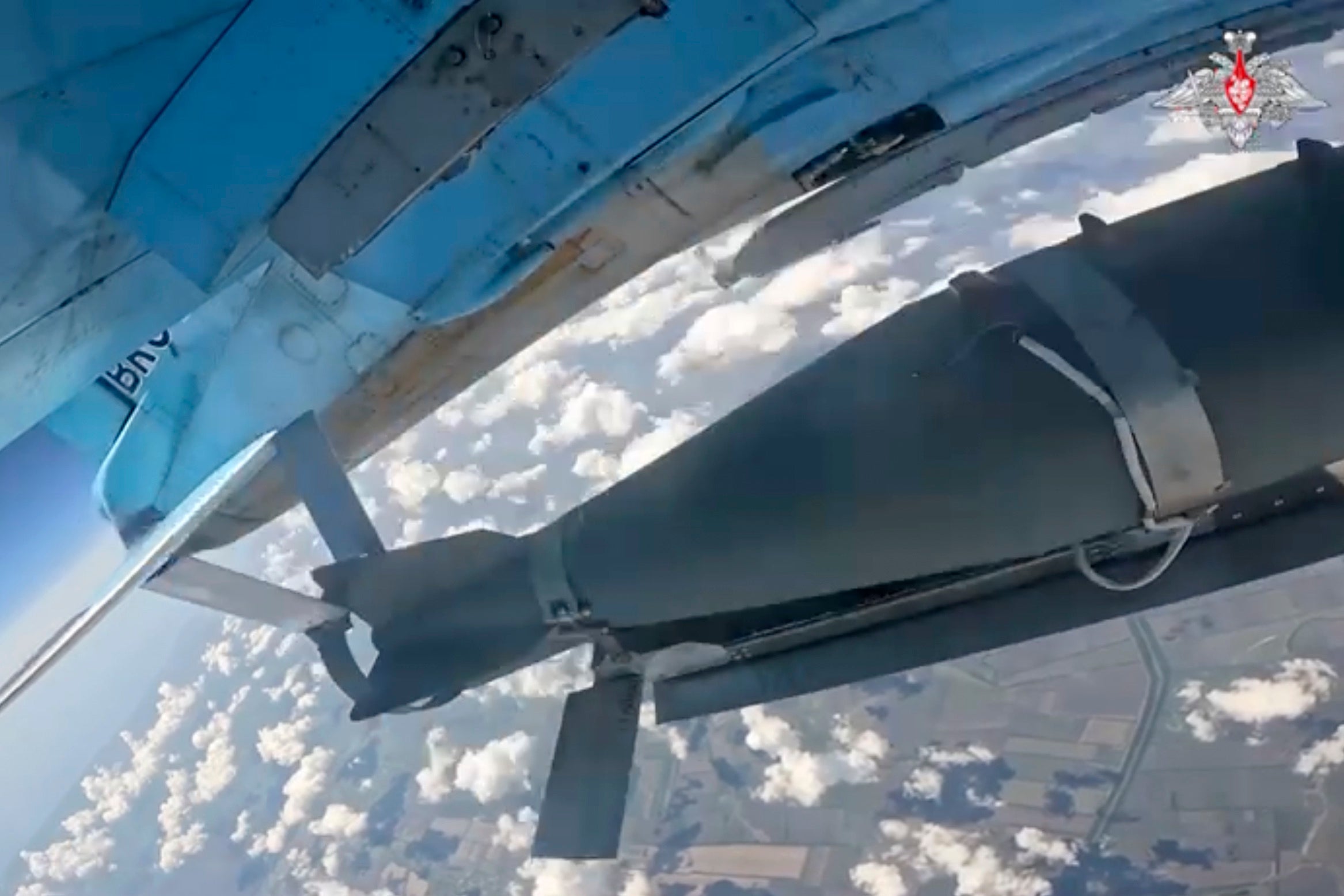The multistorey building stands alone just off a main road. The houses around it are completely destroyed, razed to the ground by relentless Russian shelling, and the dirt road is scarred by shrapnel. All that can be heard is the sound of a bomb being dropped, followed seconds later by a mighty explosion.
The bomb smashes into the ground 10 metres from the building, opening up a huge crater before a swelling fireball engulfs the entire three floors. When the smoke eventually dissipates, the footage shows the building’s whole roof has been ripped off.
This, Russian military bloggers are claiming, is the first test of a 3000kg glide bomb, otherwise known as the Fab-3000, a modified munition that is packed with nearly a tonne and a half of explosives. Earlier versions of these explosives, which are Soviet-era munitions retrofitted with fixed wings and GPS navigation systems that extend their range beyond the reach of Ukrainian anti-air defences, appeared earlier this year. These were the Fab-500s and the Fab-1500s.
This building is located on the eastern side of Lyptsi, a small village just behind the front line in the northeast Ukrainian region of Kharkiv.
Kharkiv has been under relentless ground and aerial assault since thousands of Vladimir Putin’s forces pushed over the border from Russia in mid-May. Having moved several miles towards the region’s namesake capital, home to around 1.3 million civilians, Ukraine’s forces have managed to halt the attack about two miles north of Lyptsi. It is about 20 miles from Kharkiv.
This alleged new model threatens to worsen an already dire situation facing not only Ukraine’s soldiers but the millions of civilians living within range of these glide bombs.

Since their introduction, they have killed hundreds, even perhaps thousands, of Ukrainians. Aid workers in Kharkiv city say the explosives have even rendered bomb shelters irrelevant.
“If a glide bomb hits then you’ve just got no hope,” says Ada Wordsworth, who runs a charity rebuilding homes in the wider Kharkiv region. “The destruction is so massive. It’s a weird kind of psychological torture [to face them].”
The footage posted by the Kremlin-approved Russian military blogger Fighter Bomber, believed to be in the Russian air force, purports to show a new version of the glide bombs that is twice as heavy as its predecessor, and twice as destructive.
“This is an excellent result even for a guided munition,” Fighter Bomber wrote alongside the video, before claiming that fragments of the bomb “retain their destructive power at a range of 1,240 metres”.
He added: “Here there is one bomb but you can throw 10 of them [at once].”

In March, footage showed Russia’s then defence minister, Sergei Shoigu, touring a weapons manufacturing plant located around 250 miles east of Moscow, where production of a new Fab-3000 M-54 was announced.
Ukrainian officials say they have noted the latest video, but that fragments of the weapon – which would be used to identify it – have not yet reached investigators. “All we can say for sure at the moment is that such objects have not yet been submitted to us for examination,” Natalia Nestor, deputy director of the Kyiv Scientific Research Institute of Forensic Expertise, the investigative arm of Ukraine’s Ministry of Justice said. She added that if confirmed, this would be the first piece of evidence of the Fab-3000.
The Institute for the Study of War, which monitors Russia’s invasion, is taking the footage as proof of the use of the bombs. “The fact that Russian forces have figured out how to launch FAB-3000s is a significant development,” the Washington-based think tank wrote in its latest daily update, citing the video posted by Fighter Bomber. “It will increase the destructive potential of Russia’s ongoing glide bomb attacks against Ukrainian forces and infrastructure.”
Other analysts have been more circumspect in their assessments, choosing to wait for confirmation from the ground before determining whether this marks a new weapon. In either case, the level of destruction the video shows has had people in Ukraine calling for more to be done to deal with glide bombs.

“If this is not a FREAKING MASSIVE WAKE UP CALL for finally doing everything possible and impossible to find a solution to the notorious [glide bomb] problem, I don’t know what is,” Illia Ponomarenko, Ukraine’s most followed journalist, wrote on Twitter/X.
The problem of glide bombs is “notorious” because they are extremely difficult to shoot down. The bombs’ navigation modifications mean they can be fired well beyond the range of Ukrainian air defences from deep within Russia territory.
The most effective way to stop the missiles is to shoot down the fighter jets carrying them, either in the air or while they are stationed at a base. But up until last month, Ukraine’s Western allies had barred Kyiv from using their missiles to strike over the border, meaning that fighter jets could launch these glide bombs without fear of being hit within Russia itself.
The Pentagon said on Friday that Ukraine’s military is now allowed to use longer-range missiles provided by the US to strike targets inside Russia across more than just the front lines near Kharkiv, if Kyiv is acting in self defence, opening the way for Ukraine to halt the glide problem at the source.
But Ukraine’s leaders have been clear that US-made F-16 fighter jets are also crucial for its fight against the glide bomb threat. The first batch of F-16s, from around 80 promised by several European countries, is expected to arrive in Ukraine this summer, and they will allow Kyiv to go toe to toe with Russian fighter jets while in the air.
“Against these [glide bombs], even air defence systems are not so useful,” said Mykhailo Podolyak, an aide to president Volodymyr Zelensky, last month. “Only F-16s will work.”

